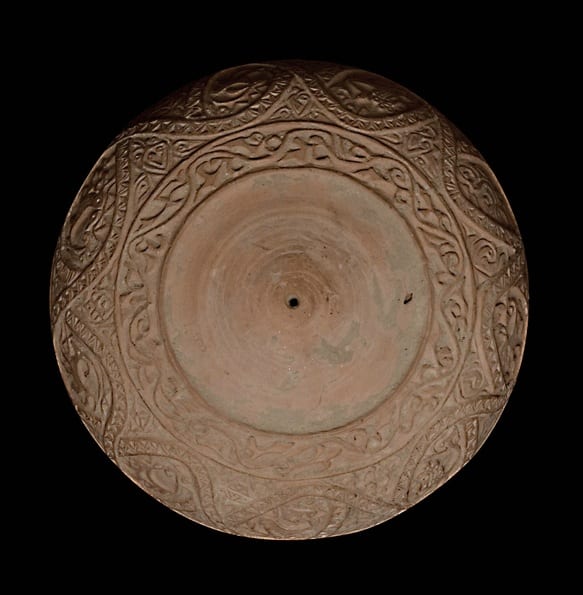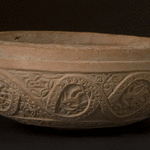Mould with Foliate Bands, 11th Century CE - 13th Century CE
Clay
6
LO.544
In spite of the ever increasing interest in Islamic ceramics, information on kilns, moulds, and other related objects is still relatively scarce. What is known is that moulds were used...
In spite of the ever increasing interest in Islamic ceramics, information on kilns, moulds, and other related objects is still relatively scarce. What is known is that moulds were used even before the creation of fritware, for the production of lead glazed relief ware during the early Abbasid period (8th-9th centuries CE), and always were made of red or buff earthenware. A reliable attribution of provenance and dating is quite a difficult task, since the actual place whence these moulds originated is not known.
The moulds can be typologically divided into two groups: moulds for the interior of the vessel and moulds for the shaping of the exterior of the vessel. The mould here illustrated is made of red earthenware in a hemispherical form and inside has a vertical join used as a handle. Since the decoration appears exclusively on the outside, it is clear that it was used for the interior decoration on a bowl of similar size. The surface is organized in concentric registers of intricate scrollwork, the sides ornamented with a undulated wave in bas-relief, set against an incised background of foliate pattern. The cavetto was left unadorned. Judging from such an intricate foliate decoration, this mould would seem to point to a 13th century dating. ) Mould, buff earthenware with moulded decoration. It was designed to shape the interior of bowls; hemispherical with a handle inside and the outside decorated with meandering scrolls which are decorated by zigzag lines and form large roundels with the figure of a bird or an animal inside. Iran or Central Asia, 10th – 11th century. Prof. Geza Fehervari Prof. Geoffrey King - (LO.544)
The moulds can be typologically divided into two groups: moulds for the interior of the vessel and moulds for the shaping of the exterior of the vessel. The mould here illustrated is made of red earthenware in a hemispherical form and inside has a vertical join used as a handle. Since the decoration appears exclusively on the outside, it is clear that it was used for the interior decoration on a bowl of similar size. The surface is organized in concentric registers of intricate scrollwork, the sides ornamented with a undulated wave in bas-relief, set against an incised background of foliate pattern. The cavetto was left unadorned. Judging from such an intricate foliate decoration, this mould would seem to point to a 13th century dating. ) Mould, buff earthenware with moulded decoration. It was designed to shape the interior of bowls; hemispherical with a handle inside and the outside decorated with meandering scrolls which are decorated by zigzag lines and form large roundels with the figure of a bird or an animal inside. Iran or Central Asia, 10th – 11th century. Prof. Geza Fehervari Prof. Geoffrey King - (LO.544)



